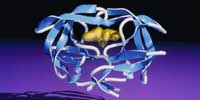

For infectious diseases the development of a single therapeutically useful compound is by no means the end of the story. Such a compound, when used on a large scale, will almost always lead to the occurrence of pathogens which have cleverly developed one or more methods to avoid the harmful effects of the drug. Resistance is also a formidable problem in the case of cancer. The processes used by resistant organisms and cancer cells to avoid the harmful effects of a drug vary widely [1]. For example, the pathogen may mutate amino acids in the target protein. A special and discomforting example is HIV reverse transcriptase mutants which are simultaneously resistant to AZT, dideoxyinosine and nevirapine [2]. Genes that affect sensitivity to a drug may be amplified, for example to increase the rate at which drugs are pumped out of the cell, leading to multi-drug resistance, a common phenomenon in cancer therapy [3]. In chloroquine-resistant malaria strains the gene for such a pump, related to that of cancer cells, is amplified [4]. Alternatively, the pathogen may recruit an entirely different enzyme to perform the same task as the original target enzyme. A typical example is found in some trimethoprim-resistant Klebsiella strains that possess a plasmid-encoded DHFR [5]. Drug metabolism can also be affected; for example, the b-lactamases destroy penicillins and cephalosporins. Recently, their mechanism has been unravelled on the basis of a crystal structure [6]. In the extreme, the pathogen may reorganize an entire enzymatic pathway, so that the drug target is simply no longer present. For example, enterococci became resistant to vancomycin by incorporating ester bonds rather than amide bonds in their cell wall, preventing the formation of a crucial hydrogen bond with a carbonyl of vancomycin [7].
The constant threat of resistance is a major source of concern. The disappointing battle against malaria is a tragic example of the recovery of a disease which once was thought to be on the road to disappearance. There exist tuberculosis strains that are simultaneously resistant to no less than nine different drugs - a truly frightening discovery [8] [9]. The only way we will be able to combat resistant pathogens with new drugs with long-lasting utility is to develop cocktails containing multiple compounds acting in diverse ways. Thus, the chances of development of resistance can be decreased, in particular for diseases where the lack of compliance is greatest. Multi-drug therapy is very successful in the case of leprosy where three compounds are administered simultaneously [10]. This serves as an example for future approaches.